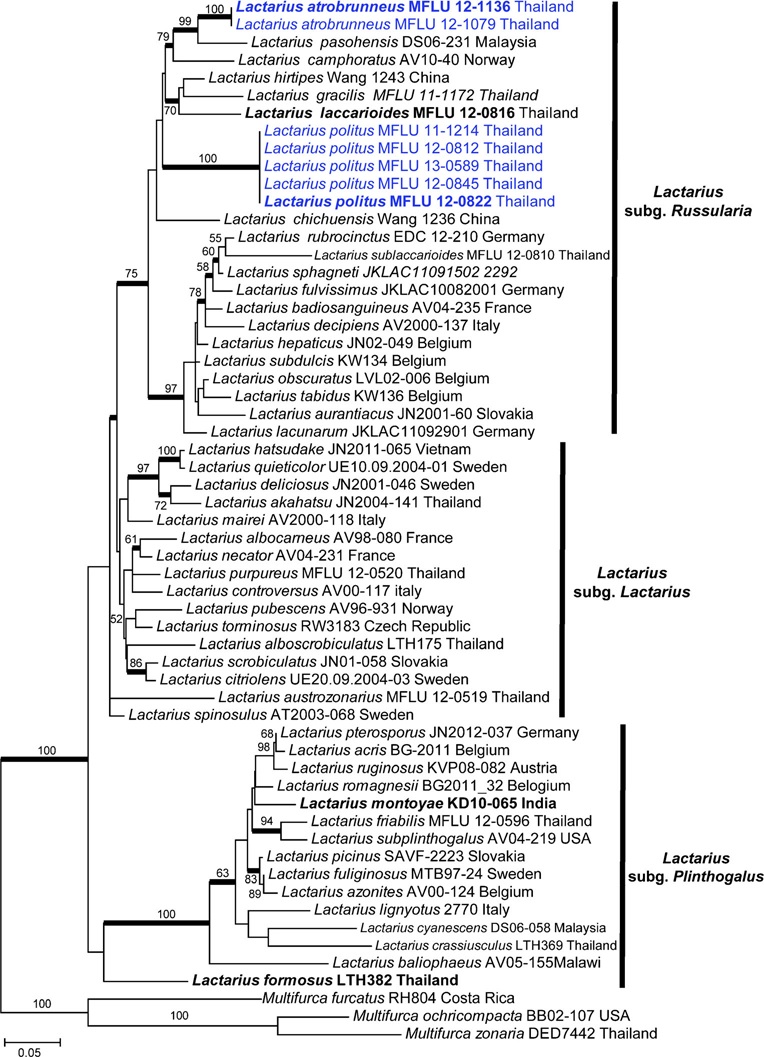Lactarius politus Wisitrassameewong & K.D. Hyde
Index Fungorum number: IF551004 Facesoffungi number: FoF00484
Etymology: politus refers to polished cap surface
Holotypus: MFLU 12–0822 Basidiocarp medium sized. Pileus 25–66mmdiam., at first broadly convex, later turning infundibuliform, inconspicuously mucronate in centre; surface dry and polished, somewhat smooth when young, becoming minutely wrinkled; margin incurved, translucently striate up to almost halfway the radius, crenulate when mature; surface reddish brown or dark brown (8F8), with darker zonation at least in inner half of pileus, palest at pileus margin, in outer half ranging from dark brown (7F8–8F8) to reddish brown (7E8) to brownish orange (5C4–C5) to brown (5E8) to olive brown (4E8) to greyish orange (5B4). Lamellae decurrent, 3 mm broad, medium crowded, sometimes forked, with 1–2 series of lamellulae, light yellow (4A4) to greyish yellow (4B4) to olive brown (4D5–E3), with greyish brown (5E3) tinge. Stipe 30–62×5–8mm, cylindrical; surface dry, longitudinally wrinkled, brown (5E5) to greyish orange (6B3) to dark brown (9F8). Context 2 mm broad in pileus, medium firm, hollow in stipe, greyish pink; smell strong, sweetish and spicy, maggi-like in dried specimens; unchanging with 10 % KOH and unchanging with FeSO4. Latex transparent, unchanging on exposure, unchanging with 10 % KOH, unchanging on white tissue or paper; taste mild. Basidiospores globose to subglobose, sometimes ellipsoid; 7.7 8.6–9–10.2(−10.6)×6.7–7.6–7.8–8.7μm; Q=1.03–1.11–1.17–1.33 (n=80); ornamentation amyloid, reticulate, ornamented with very heavy, dense and high ridges up to 2.5μm; ridges irregular and thick interconnected with finer lines, forming a dense reticulum, sometimes with a slight tendency of zebroid ornamentation; plage sometimes distally amyloid. Basidia 55–84×18–23μm, 4 spored, subclavate, with guttulate contents. Pleuromacrocystidia very scarce, 55–77×16–20μm, not emergent, subfusiform to subclavate, mucronate to rounded, with small granules and guttulate contents. Pseudocystidia 3–6μm diam., not emergent, tortuous cylindrical, often curved, sometimes ramified. Lamellae edge heterogeneous, with some basidia present; marginal cells subcylindrical to subclavate to obovoid to capitate, 25–43× 11–22μm; cheilocystidia scarce, 30–55×8–14μm, not emergent, subcylindrical to subclavate, with mucronate apex. Lamellar trama consisting of small and large globose cells, septate hyphae and lactiferous hyphae. Pileipellis a hyphoepithelium; upper layer 20–30μm thick, consisting of repent cylindrical hyphae; subpellis consisting of globose cells of 10–40μm diam.
Habitat: solitary or scattered on soil in montane tropical forest near Lithocarpus sootepensis stand.
Material examined: THAILAND, Chiang Rai Province, Mae Fah Luang district, Doi Mae Salong Nok sub-district, Doi Mae Salong, elev. ca 1269 msl., N20°16.90 E99°62.30, 13 July 2012, KW351 (MFLU 12–0822, holotype, isotype in GENT; GenBank ITS: KF433019), ibid., 22 August 2012, KW396 (MFLU 12–0845, paratype, isoparatype in GENT; GenBank ITS: KF433018), ibid., 10 September 2013, KW468 (MFLU13–0589, paratype, isoparatype in GENT; GenBank ITS: KP744445); Chiang Mai province, Mae Taeng district, Pa Pae sub-district, Mushroom Research Center, elev. ca 900 msl., N19°07.20 E98°44.04, 3 July 2012, KW331(MFLU 12–0812, paratype, isoparatype in GENT; GenBank ITS: KF433020), Chiang Mai province, Bahn Mae Sae village, on Highway no.1095 near 50 km marker, elev. ca 962 msl., N19°14.59 E098°39.45, 4 July 2011, KW107 (MFLU 11–1214, paratype, isoparatype in GENT; GenBank ITS: KP744444)
Notes: Lactarius politus is recognized by its large, ellipsoid spores and firm ornamentation forming a complete reticulum. The other important characters are the watery latex and the strong smell. The species is rather variable in pileus colour which could be brown zonation or rather even dark brown in inner half of pileus and with paler margin. The pileipellis structure is hyphoepithelium which is common feature in subgenus Russularia.

Lactarius politus (MFLU 12–0822, holotype). Basidiocarp in the field (photo by K. Wisitrassameewong)
Read more: http://link.springer.com/article/10.1007/s13225-015-0324-y

